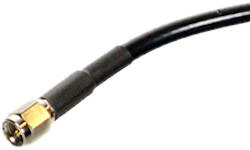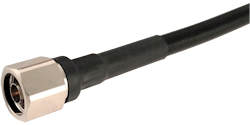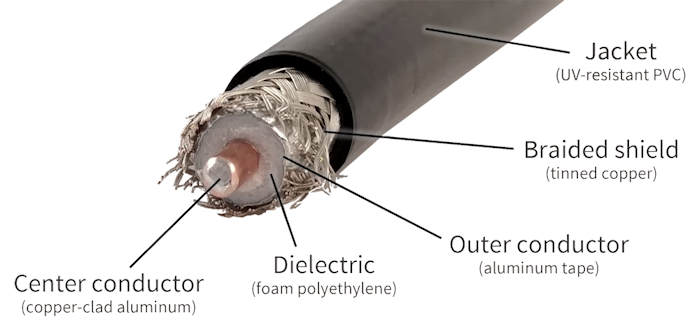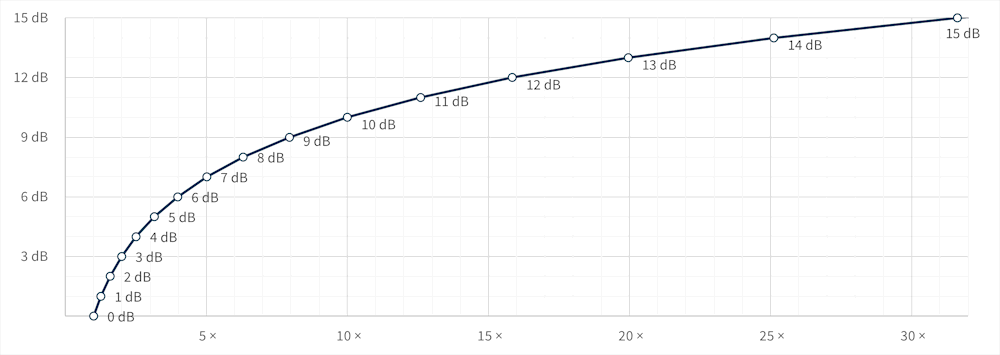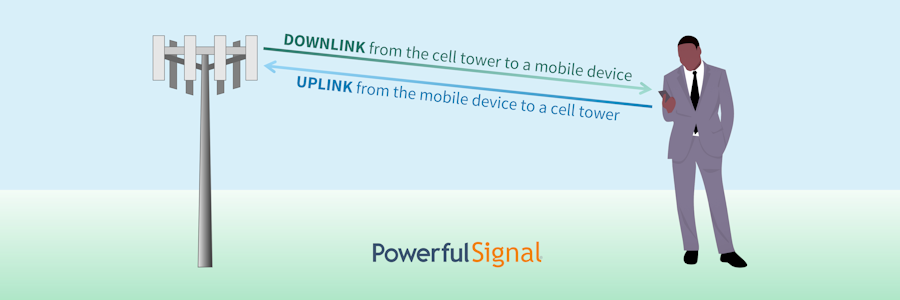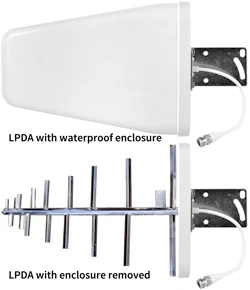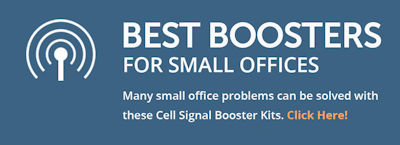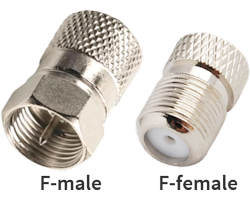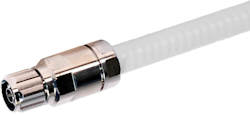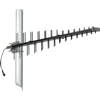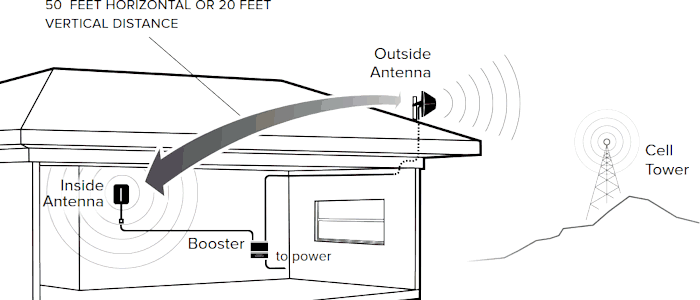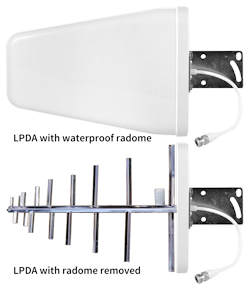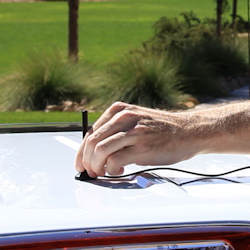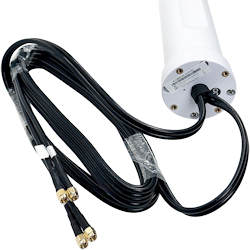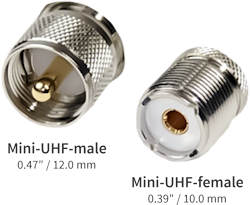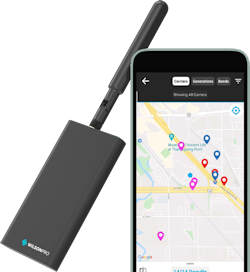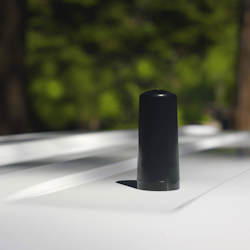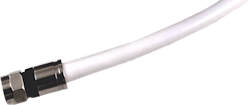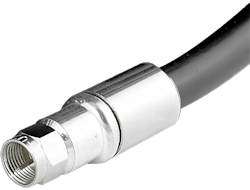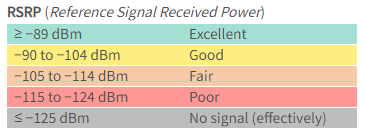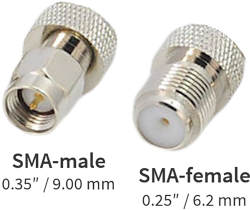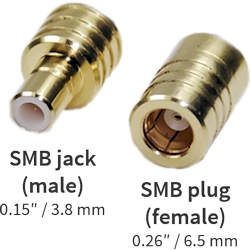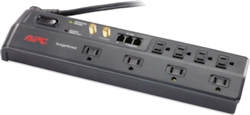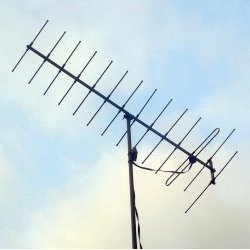Glossary of cellular and cell phone signal booster terms
Definitions of cellular and cell phone signal booster terms

Updated
#
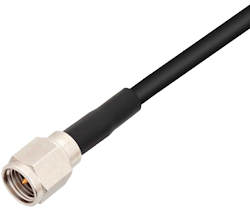
100 coax is a 50-ohm coaxial cable with an outer diameter of 0.110″ (2.79 mm). It is marketed and sold under various brand names, including LMR®-100.
100 coax has less attenuation than RG-174 coax but is almost exactly the same diameter. Its size, performance, and flexibility make it ideal for use in runs up to 15′ for use with 50-ohm cell phone signal boosters in vehicles.
100 coax is commonly terminated with SMA-male connectors.
195 coax is a 50-ohm coaxial cable with an outer diameter of 0.195″ (4.95 mm). It is marketed and sold under various brand names, including LMR®-195 and TS-195™.
195 coax has less attenuation than RG-58 coax but is almost exactly the same diameter. Its size, performance, and flexibility make it ideal for use as a jumper cable and in runs up to 30′ for use with 50-ohm cell phone signal boosters in RVs and buildings.
195 coax is commonly terminated with SMA-male or N-male connectors.
Click here to see 195 coax cables available from Powerful Signal.

200 coax is a 50-ohm coaxial cable with an outer diameter of 0.195″ (4.95 mm). It is marketed and sold under various brand names, including LMR®-200 and HiBoost200.
200 coax has more attenuation than 400 coax but is thinner and more flexible. Its size and flexibility make it an occasional choice for runs of cable up to 30′ for use with 50-ohm cell phone signal boosters in buildings.
200 coax is commonly terminated with N-male connectors.
240 coax is a 50-ohm coaxial cable with an outer diameter of 0.240″ (6.1 mm). It is marketed and sold under various brand names, including LMR®-240 and TS-240™.
240 coax has more attenuation than 400 coax but is thinner and somewhat more flexible. Its size and flexibility make it an occasional choice for runs of cable up to 30′ for use with cell phone signal boosters in buildings.
240 coax is commonly terminated with FME-male, FME-female, or N-male connectors.
Click here to see 240 coax cables available from Powerful Signal.
3G refers to the third generation of broadband cellular network technology.
3G improved on 2G networks by offering higher mobile data speeds, always-on mobile data, and greater network capacity. 3G made the mobile internet possible.
3G networks, phones, and cell phone signal boosters were referred to as dual band because they used two bands of cellular frequency (band 2 and band 5).
Major US cellular carriers shut off 3G service nationwide in 2022.
400 coax is a 50-ohm coaxial cable with an outer diameter of 0.405″ (10.29 mm). It is marketed and sold under various brand names, including LMR®-400 and TS-400™.
400 coax has less attenuation than 240 coax but is thicker and somewhat less flexible. Its low-loss, sturdy N connectors make it a excellent choice for runs of cable up to 100′ for use with cell phone signal boosters in homes and businesses. (Half-inch coax is preferred for runs longer than 100′.)
400 coax is terminated with N-male connectors.
Click here to see 400 coax cables available from Powerful Signal.
4G refers to the fourth generation of broadband cellular network technology.
4G improved on 3G networks by offering higher mobile data speeds, digital voice calling (Voice over IP or VoIP), the ability to use a cell phone as a WiFi hotspot, and greater network capacity.
4G networks use the same bands of cellular frequency as 3G networks. There were also the first to use new bands such as band 4, band 12, and band 13.
4G will continue to be the “backbone” of cellular networks for the foreseeable future, while being supplemented and enhanced by 5G.
See also: LTE
50 ohms is the most common impedance used for commercial cell phone signal boosters and their components (like coaxial cable). Many home and mobile boosters are also 50-ohm systems.
50 ohms became a standard impedance in the telecommunications industry because it is the best compromise between minimum attenuation, maximum power, and maximum voltage.
50-ohm cell signal boosters use N connectors, SMA connectors, and FME connectors.
Compare: 75-ohm
Learn more about 50-ohm vs. 75-ohm cell signal boosters in our Knowledge Base.
5G refers to the fifth generation of broadband cellular network technology. Its technical name is 5G NR (5th Generation New Radio).
5G improves on 4G networks by offering higher mobile data speeds with lower latency (time between request and response) and greatly increased network capacity for use by IoT devices.
5G networks use the same bands of cellular frequency as 4G, while also greatly expanding the spectrum of radio frequencies used by cellular devices up into the mmWave spectrum. 5G band numbers are preceded by a lowercase n (e.g., band n5, band n260).
5G networks operate alongside 4G networks, and most cellular devices first connect to a 4G network before being handed off to a 5G network and frequency. 5G will eventually replace 4G as a standalone service, but that handover date is still years away.
See also: 5G standalone; 5G non-standalone
5G non-standalone (5G NSA) is a cellular network that uses a hybrid of 5G and 4G standards, protocols, and infrastructure. It provides some of the features and benefits of a pure 5G network, while still leveraging the existing infrastructure of 4G networks.
5G NSA networks may use two bands of cellular frequency, with 4G on the uplink frequency from the phone to the cell tower and 5G on the downlink frequency from the tower to the phone; this allows the phone to make use of faster 5G speeds for the data it is receiving from the network.
See also: 5G standalone; 5G non-standalone
5G standalone (5G SA) is a cellular network that uses 5G standards, protocols, and infrastructure without relying on 4G LTE technologies or infrastructure. It’s a “pure 5G” network, without any data speed limitations of 4G.
See also: 5G non-standalone
75 ohms is a common impedance used for home cell phone signal boosters and their components (like coaxial cable). Some commercial boosters are also 75-ohm systems.
75 ohms became a standard impedance in the telecommunications industry because it has the lowest attenuation.
75-ohm cell signal boosters typically use F connectors.
Compare: 50-ohm
Learn more about 50-ohm vs. 75-ohm cell signal boosters in our Knowledge Base.
A
See: DAS
Automatic gain control (AGC) regulates and maintains consistent signal strength in a cell phone signal booster.
AGC optimizes the performance of the signal booster by automatically adjusting the gain of the incoming signal. If the incoming signal is weak, AGC increases the booster’s gain; if the signal is too strong, AGC reduces the booster’s gain to prevent it from overpowering and shutting down.
When a smartphone or other cellular device is powered on, it searches first for a specific band of cellular frequency to which it can connect and authenticate itself on the carrier’s network. For example, many smartphones will look first for a low-frequency band (like band 12, band 17, or band 5), because those bands penetrate walls more easily and are therefore more likely to be found inside buildings. This band of frequency is the anchor band (also called the pilot band).
Once the carrier has authenticated the device via the anchor band, the phone will then search for and connect to another band (if available) that offers a stronger connection and faster data.
Most 5G devices anchor to a 4G band before being handed off to a 5G connection.
An antenna is a physical device that acts as the interface between two transceivers—electronic devices that both transmit and receive electromagnetic waves, such as the signals used by cellular phones. The antenna receives electrical current from a device (like a cell phone signal booster) through a coaxial cable and and transmits that current through the air as an electromagnetic wave; it also receives electromagnetic waves over the air and sends them as electrical current back through the cable to the device.
The booster’s donor antenna is the uplink path to and from one or more cell towers. The booster’s broadcast antenna is the downlink path to and from cellular phones and devices inside the building or vehicle.
A cellular router uses MIMO antennas for uplink and downlink.
Marine antennas are designed and constructed to resist saltwater spray.
Antennas come in different shapes and sizes that work best in different situations. The types of antennas commonly used with cell signal boosters and cellular routers are:
- Directional antennas (including LPDA, panel, parabolic, and Yagi antennas).
- Omnidirectional antennas (including desktop, dome, NMO, paddle, and whip antennas).
See also: Gain (antenna)
An access point name (APN) is the hostname of the gateway that a smartphone or cellular router uses to access the internet.
Any device that connects to the internet goes through a gateway, a server or router that passes data to and from devices inside its own network to other networks, including the internet. A gateway typically has an assigned hostname that allows devices inside its network to identify and connect to it.
An APN is a hostname used by smartphones and cellular routers to access the internet. An APN that matches the carrier and SIM card must be entered correctly into the phone or router’s settings.
Common APNs for the major carriers include vzwinternet (Verizon), nxtgenphone and broadband (AT&T
), and fast.t-mobile.com (T- Mobile
). The APN for your phone or router may be different, so check with your carrier when you install a new SIM card in your device.
Attenuation is the decrease in signal strength as a signal passes along a coaxial cable or through a connector or other medium. Cell phone signal boosters reverse the effects of attenuation.
Attenuation is increased (the signal loses more strength) over longer distances through the same type of coax cable. It’s also increased as signal is scattered or absorbed by building walls, terrain, trees, etc.
Attenuation can be decreased by using a shorter cable or a different type of cable with less loss over the same distance. It’s for this reason that using the shortest run of cable possible is generally the best practice when connecting antennas to cell signal boosters.
Attenuation also varies in the same cable of the same length depending on the signal’s frequency: Lower frequencies have less attenuation while higher frequencies have greater attenuation.
Attenuation is measured in decibels (dB).
See also: Attenuator
Learn more about coaxial cable attenuation in our Knowledge Base.
An attenuator is a component that provides attenuation (a reduction in the signal strength) between an antenna and a cell phone signal booster.
Attenuators are sometimes used in situations where outside cellular signal is so strong that it’s causing the booster to overpower or shut down. In this circumstance, the attenuator is installed between the booster and the coaxial cable running to the outside donor antenna.
Attenuators are also sometimes used when the booster’s downlink power is so strong that it’s causing signal oscillation. In this circumstance, the attenuator is installed between the booster and the coaxial cable running to the inside broadcast antenna.
Click here to see attenuators available from Powerful Signal.
The Advanced Wireless Service (AWS) occupies a spectrum of low-band cellular frequencies between 1710 and 1780 MHz (uplink) and between 2110 and 2200 MHz (downlink).
AWS came into service in 2006 to provide additional capacity for 3G and 4G cellular phones.
The AWS spectrum was originally auctioned off to carriers as band 4, blocks A–F. More spectrum was opened later with band 66, which adds additional blocks G–J. (Band 4 is now a subset of band 66.)
AWS blocks A–F are amplified by five-band cell phone signal boosters.
See also: Service
B
A band is a spectrum of radio frequencies set aside for a specific use to prevent interference and allow for orderly and efficient use of the radio spectrum.
Specific bands between 617 MHz and 48 GHz have been reserved for exclusive use by cellular phones and devices.
Some bands are divided into specific ranges reserved for uplink transmission and downlink transmission.
In the United States, bands are regulated and licensed by the FCC.
Cellular spectrum chart for 700 MHz (SMH), which includes bands 12, 13, 14, 17, and 29:
Band 71 is a spectrum of low-band cellular frequencies between 617 and 698 MHz.
Band 71 was auctioned off by the FCC in 2016 to provide additional capacity for 4G and 5G cellular phones in remote and rural areas. Prior to that, the 600 MHz spectrum was used by UHF television channels 38–51.
Most band 71 licenses are owned by T-Mobile.
Band 71 is currently amplified by a few industrial cell phone signal boosters.
See also: Band
Bandwidth is the width of the band of frequency, expressed in MHz or GHz.
For example, cellular SMH band 13 has a downlink spectrum of 746–758 MHz and an uplink spectrum of 776–788 MHz. (See diagram.) The total bandwidth for band 13 is therefore 24 MHz: (758−746)+(788−776)=24.
The more bandwidth in a band of frequency, the greater capacity that band has to support cellular devices and heavier data use. With the advent of 5G cell phones and IoT devices, newer 5G bands have much wider bandwidth than older 4G and 3G bands.
Cellular spectrum chart for the PCS service, which has a total bandwidth of 130 MHz (1850–1915 MHz/1930–1995 MHz):
A barrel connector is a connector that has the same connector type on both ends (for example, F-female to F-female).
A barrel connector allows you attach two coaxial cables with same connectors together to create one longer run of cable.
See also: Bulkhead connector
Click here to see barrel connectors available from Powerful Signal.
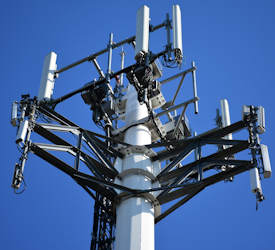
A base station is an antenna or cluster of antennas in a specific location that are operated by a carrier and provide cellular service. These antennas may be pointed in all directions or may be aimed in specific directions, depending on where local cellular coverage is needed.
A single cell tower may be owned by a specific carrier and be the base station for just that carrier’s service, or the owner of the tower may lease space on it to multiple carriers to operate base stations.
See also: Neighbor cell; Serving cell
Beamwidth refers to the angular width of the main lobe of the radiation pattern of an antenna. The main lobe is the central part of the pattern where the antenna’s gain is the strongest; it’s surrounded by smaller lobes and nulls (directions where gain is significantly weaker or zero).
A narrow beamwidth indicates that the antenna concentrates its energy in a specific direction, while a wider beamwidth means the energy is spread over a larger angle.
Since an antenna’s radiation pattern is a three-dimensional shape, beamwidth is measured horizontally and vertically:
- Horizontal beamwidth represents how wide or narrow the coverage is in the left–right direction when looking at the antenna from the top (the horizontal plane).
- Vertical beamwidth represents how tall or short the coverage is in the up–down direction when looking at the antenna from the side (the vertical plane).
The beamwidth of an antenna is usually measured at the points where the signal strength has dropped to a certain percentage of the maximum signal strength in the main lobe. Commonly used fractions for measuring beamwidth include half-power (−3 dB) and quarter-power (−6 dB) points.
For a directional antenna, as the antenna’s gain increases, its horizontal and vertical beamwidths become narrower and longer. Higher-gain antennas require more precise tuning (aiming at the cell tower or other transceiver) than lower-gain antennas, which have wider beamwidths and are more forgiving about directionality.
An omnidirectional antenna has a horizontal beamwidth of 360°—it sends and receive in all directions on a horizontal plane. As the antenna’s gain increases, its vertical beamwidth flattens and extends outward into a disc shape.
Choosing the right antenna beamwidth depends on the specific application and the desired coverage area. A narrower beamwidth provides more focused and concentrated coverage, while a wider beamwidth offers broader coverage at a lower signal strength.
A block is a subset spectrum of radio frequencies within a band.
Blocks allow the FCC to auction off licenses to carriers so they can use the same band in the same geographical area. For example, AT&T may hold the license for block B of band 12 in a certain large city, while T-Mobile may hold the license for block C in the same city; this would allow both carriers to use band 12 without causing interference on each other’s networks.
Cellular spectrum chart for 700 MHz (SMH), which includes blocks A–E of bands 12, 13, 14, 17, and 29:

Bluetooth is a short-range, peer-to-peer wireless technology that allows electronic devices to connect to each other.
Bluetooth technology has many uses, including connecting a cellular phone to a wireless headset, a wireless keyboard, or a hands-free navigation and entertainment system in an automobile.
Some cell phone signal boosters have Bluetooth smartphone apps that allow you to monitor the booster’s performance and change its settings.
See: Wideband antenna
In a cell phone signal booster system, the broadcast antenna (also called the server antenna) is the antenna inside the building or vehicle that provides amplified downlink signal to cellular phones and devices.
The broadcast antenna connects to the booster’s inside port via a coaxial cable.
A broadcast antenna is either a directional or an omnidirectional antenna.
Common types of broadcast antennas include dome, panel, desktop,and paddle antennas.
See also: Donor antenna; Isolation
Click here to see in-building broadcast antennas available from Powerful Signal.
Broadband Radio Service (BRS) and Educational Broadband Service (EBS) occupy a spectrum of mid-band cellular frequencies between 2496 and 2690 MHz (2.496–2.690 GHz).
Cellular phones on this band are high power user equipment (HPUE), with up to 31 dBm of uplink power, more than six times that of consumer phones on other bands. The greater uplink power allows BRS/EBS cellular signals to travel farther and penetrate building walls better.
This frequency spectrum was originally reserved for commercial (BRS) and educational (EBS) wireless video broadcasts. In the mid-2000s, it was licensed to the wireless cellular carrier Sprint and used for their WiMax service.
BRS/EBS is now band 41, which is owned exclusively by T-Mobile and used for their mid-band 5G service.
BRS/EBS is not currently amplified by cell phone signal boosters.
See also: Service
A bulkhead connector is a type of barrel connector that’s inserted in a panel or thin surface and serves as a pass-through connector for coaxial cables.
For example, if a boat owner needs to connect an outside donor antenna to a cell phone signal booster, the owner could install a bulkhead connector in the boat’s top deck, attach the donor antenna’s cable to the bulkhead connector’s outside connection, and attach another cable that runs from the bulkhead connector’s inside connection to the booster.
Click here to see the Top Signal N-female bulkhead connector.
C
C band (band 77) occupies a spectrum of mid-band cellular frequencies between 3700 and 4200 MHz (3.7–4.2 GHz).
This frequency spectrum was originally reserved for commercial satellite TV and data, but it has recently been reallocated by the FCC for use by 5G cellular networks. It’s also used by airplane radio altimeters, so cellular C-band deployments have been restricted near airports.
C band is currently amplified by a few industrial cell phone signal boosters.
See also: Service
Capacity is the amount of user activity (or traffic) that a cellular network is capable of handling. The greater the capacity, the more users and traffic the network can handle.
Capacity affects mobile data speeds and the ability of phones and other cellular devices to connect to a cellular tower, especially at a distance. As traffic increases, cell towers reduce their downlink power, making it more difficult for distant cell phones to establish a connection.
A cell phone signal booster can improve the connection to a distant tower that’s reduced its downlink because of capacity issues.
A wireless carrier—also called a mobile network operator (MNO)—is a company that provides cellular service by selling access to its wireless network.
Major and regional carriers own and operate their own wireless infrastructure, including cell towers (base stations), base station controllers, switching centers, and other hardware and communications links.
The three largest major carriers in the United States are Verizon, AT&T
, and T-Mobile
; examples of regional carriers include UScellular
and GCI Alaska
.
A carrier that does not own its own infrastructure is called an MVNO.
When a 4G or 5G cellular phone communicates with a cell tower, it typically uses one band of cellular frequency for downlink and uplink. With carrier aggregation, the tower uses two different bands simultaneously to increase throughput for faster data speeds and greater capacity.
A carrier-agnostic cell phone signal booster is a wideband booster that amplifies cellular signal from all carriers simultaneously, without regard to which carrier is transmitting the signal. The booster is designed to amplify specific bands of frequency, regardless of how many carriers in the area are using those bands.
Most dual-band and five-band boosters are carrier-agnostic and will work with any major or regional carrier or MVNO.
See also: Carrier-specific
A carrier-specific cell phone signal booster amplifies cellular signal from one carrier only. A carrier-specific booster may amplify one band or multiple bands of frequency used by that carrier.
Some carrier-specific boosters will allow you to change the carrier that they amplify. This is usually done with a smartphone app or touchscreen menu.
Carrier-specific boosters typically have a higher maximum gain than carrier-agnostic boosters. They also create less noise and therefore broadcast higher-quality cellular signal than carrier-agnostic boosters.
Citizen Broadband Radio Service (CBRS) occupies a spectrum of mid-band cellular frequencies between 3550 and 3700 MHz (3.55–3.7 GHz).
This frequency spectrum was originally reserved for military radar and satellite communications. The spectrum is now licensed by the FCC and shared with cellular carriers as band 48.
BRS/EBS is not currently amplified by cell phone signal boosters.
See also: Service
A cell phone signal booster—also called a cellular amplifier—is an electronic device designed to increase the strength of cellular signals within a specific area.
Boosters are typically used in remote or rural areas where outdoor cellular signal is weak. They are also used in areas where outdoor signal is adequate but dense or reflective construction materials prevent the signal from reaching phones inside a building.
Most cellular boosters have four primary components:
- The outdoor donor antenna transmits cellular signal to and from the cell tower.
- The booster takes the weak signal it receives from the donor antenna, increases its gain, and sends it to the broadcast antenna.
- The indoor broadcast antenna transmits the amplified signal to phones and other cellular devices inside the building or vehicle.
- Coaxial cables connect the donor and broadcast antennas to the booster.
Different types of cell signal boosters are designed for use in commercial buildings, in homes, and in vehicles. Consumer cell phone signal boosters are preapproved by the FCC for use without a license; industrial cell phone signal boosters require carrier permission to operate.
Cell signal boosters are commonly sold as complete kits; installers can also use individual components to design a custom booster system for a commercial building or large home.
See also: Cellular router
Click here to see cell phone signal boosters available from Powerful Signal.
Click here to learn about custom cell phone signal booster solutions for large homes.
See: Base station
CELLFLEX is a registered trademark of RFS Technologies for their brand of half-inch coaxial cable.
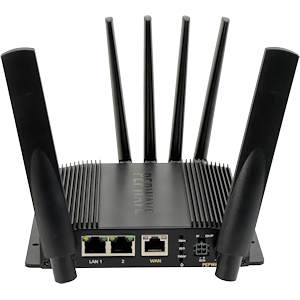
A cellular router converts 4G and 5G cellular signal to WiFi signal and creates a WiFi network that can be used by laptop computers, tablets, smartphones, smart TVs, security cameras, and other WiFi-enabled devices.
A router is used instead of a cell phone signal booster when outdoor cell signal is fair or good and/or when your need is to produce WiFi signal instead of stronger cellular signal.
Cellular routers are often used in RVs and in homes and businesses that don’t have access to other high-speed internet services.
Most cellular routers have two or four connectors for a MIMO antenna that can improve reception of cellular signal for stronger, faster WiFi.
See also: FWA (fixed wireless access)
A channel is a narrow spectrum of radio frequencies set aside for a specific use to prevent interference and allow for orderly and efficient use of the radio spectrum.
Between 1952 and 2009 frequencies between 470 and 890 MHz were allocated by the FCC for use by terrestrial UHF television stations as TV channels 14–83. In 2009, UHF channels 52–69 were reallocated by the FCC for the SMH cellular service (as seen in the table below). In 2016, UHF channels 38–51 (614–698 MHz) were reallocated for cellular band 71.
Channels are an important feature of WiFi frequencies, family-band radios, and other forms of radio communication.
Cellular spectrum chart for 700 MHz (SMH), which includes bands 12, 13, 14, 17, and 29:
The Cellular service (CLR) occupies a spectrum of low-band cellular frequencies between 814 and 894 MHz.
This frequency spectrum was the first one allocated by the FCC for use with analog cellular phones, so it was simply called Cellular or Cellular 850 (because the center of its spectrum is around 850 MHz). Other cellular frequencies have been allocated since then, but it still used by most cellular carriers.
Today, the CLR spectrum is part of band 5 (824–894 MHz), which is subset of band 26 (814–894 MHz). It is used for both 4G and 5G cellular service.
CLR band 5 is amplified by most cell phone signal boosters.
A coaxial cable (or coax cable) is an electrical cable used as a transmission line for radio frequency signals.
A coaxial cable has four parts:
- The center conductor is a wire that transmits electromagnetic (EM) signals. It’s made of solid copper or another copper-clad metal.
- Surrounding the center conductor is a dielectric insulator (commonly made of PE plastic) that keeps a uniform distance between the center conductor and the outer conductor. The dielectric prevents interference between signals being transmitted in both directions and minimizes signal loss.
- The outer conductor is a metal (typically aluminum) shield that surrounds the dielectric. It serves as the ground reference and prevents signal leakage and EM interference from other cables. Larger cables may also have a braided shield around the outer conductor that provides additional shielding and flexibility.
- Surrounding the shield is the outer jacket that protects the cable. The jacket is often made of PVC plastic that is resistant to ultraviolet light; it may also be made of fire-resistant materials for use in plenum spaces.
Each end of a coax cable is terminated with a connector that allows the cable to be attached to an electronic device or an antenna. Coax cables are sold preterminated with connectors already affixed to each end and in bulk unterminated rolls for use with crimp connectors.
Coax cables come in various sizes and lengths, two impedances, and with various types of connectors. The choice of cable depends on the application. Thicker cables have less attenuation and are therefore needed for longer cable runs.
Coax cables are one component of a cell phone signal booster system; they are used to send cellular signal between the booster and its donor antenna and broadcast antenna.
Common types of cables used with 50-ohm boosters include:
Common types of cables used with 75-ohm boosters include:
See also: Fiber-optic cable
Click here to see coaxial cables available from Powerful Signal.
Connectors are used to terminate a coaxial cable so the cable can be connected to a cell phone signal booster or an antenna.
Double-headed connectors can also be used to adapt two components that have different connectors. For example, an SMA-male/N-male adapter may be used to hook up a 400 coax cable with N-male connectors to a cell signal booster that has SMA-female connectors.
Common types of connectors used with cell signal boosters include:
A connector on a cell signal booster is sometimes called a port.
See also: Barrel connector; Bulkhead connector; Crimp connector
Click here to see connectors available from Powerful Signal.
Consumer cell phone signal boosters are preapproved by the FCC for use without a license to operate the booster equipment. (Registration of the booster with your carrier is required, however.)
Consumer boosters are sometimes called “Part 20” equipment, referring to the section of the Code of Federal Regulations that regulates consumer boosters (47 CFR §20.21).
See also: Industrial cell phone signal booster
A coupler (also called a tap) splits the signal from a coaxial cable into two unequal runs, sending a lesser amount of signal to an antenna and a greater amount further down the line to another antenna or another coupler.
If you need to divide signal equally, you would use a splitter instead.
Couplers are typically used in commercial cell phone signal booster installations. The amplifier must provide sufficient signal strength to overcome the attenuation (signal loss) involved in tapping a cable. Couplers may also be used in some large residential applications.
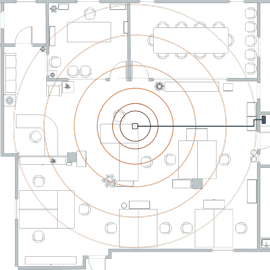
Cell phone signal boosters designed for use in commercial buildings and homes provide amplified signal coverage for a certain amount of indoor area. That coverage area is typically measured in square feet (ft2).
A booster system’s stated coverage area is an estimate prepared by the manufacturer or by the reseller. It is not a guaranteed amount of coverage; it’s a rough calculation based on the booster’s gain and downlink power.
The size of the coverage area you experience may vary from the estimate, based on:
- Cellular frequencies being amplified. Lower-band frequencies (like SMH and CLR) travel farther and penetrate walls more easily than higher-band frequencies (like AWS and PCS).
- Outside signal strength received by the donor antenna. The stronger the outside signal, the more coverage the booster will be able to provide inside.
- Indoor building materials. Cellular signal passes through drywall and wood framing more easily than through brick, concrete, and dense wood.
- Which donor antenna you use. A directional antenna will provide higher gain than an omnidirectional antenna, but a directional antenna may not work best in all situations.
- Which broadcast antenna(s) you use and where you place it/them. All broadcast antennas provide stronger signal close to the antenna and progressively weaker signal the farther one gets from the location where the antenna is mounted.
Keeping all of the factors above in mind, a good rule of thumb is to reduce the booster’s coverage estimate by half when planning for how much indoor area will have strong cellular signal and the fastest internet data speeds.
A crimp connector is a connector that can be attached to unterminated coaxial cable by the installer of a cell phone signal booster system.
Crimp connectors are used with bulk, unterminated coax cable to create custom cable lengths without any excess cable. Because attaching crimp connectors to coax cables requires special tools—a cable prep tool and a ratchet crimping tool—terminating bulk coax is usually done by professional installers.
Click here to see crimp connectors available from Powerful Signal.
Click here to see installer tools available from Powerful Signal.
D
A distributed antenna system (DAS) is a type of cell phone signal booster used in commercial buildings and large homes.
An active DAS system uses a fiber optic cable connection as the backhaul to a wireless carrier’s network to provide voice and data.
A passive DAS system uses a donor antenna as its data source and coaxial cable or Ethernet cable to connect all components in the system.
A hybrid DAS system uses coaxial cable for runs to the antennas and fiber optic cable to connect amplifier equipment, providing scalability with near-zero attenuation.
Learn about the differences between active, passive, and hybrid DAS in our Knowledge Base.
The decibel (dB) is a relative unit of measurement that expresses the ratio of two values of power, such as radio (including cellular) signals, electrical voltage, and sound volume.
The decibel scale is logarithmic, which is a way of displaying a wide range of numbers compactly. The linear value of a logarithm is calculated by the equation 10(dB/10).
For example:
- An increase of 3 dB doubles the value: 10(3/10)=1.995
- A decrease of 3 dB reduces the value by 50 percent: 10(−3/10)=0.501
- An increase of 5 dB is a little over 3 times the value: 10(5/10)=3.16
- An increase of 7 dB is 5 times the value: 10(7/10)=5.01
- An increase of 10 dB is 10 times the value: 10(10/10)=10
- An increase of 20 dB is 100 times the value: 10(20/10)=100
- An increase of 30 dB is 1,000 times the value: 10(30/10)=1,000
The gain of cell phone signal boosters is expressed in decibels. For example, a booster that has a maximum gain of 50 dB can increase the strength of the cellular signal it receives from the donor antenna up to 100,000 times: 10(50/10)=100,000.
Decibels isotropic (dBi) is a measurement of an antenna’s gain, or how efficient it is at sending and receiving signal in a specific direction.
dBi is measured using the decibel scale (dB), which is logarithmic.
The decibel-milliwatt (dBm) expresses the power of transmitted and received cellular signal in milliwatts (mW) using the decibel (dB) scale. 1 milliwatt is 1⁄1000th of a watt (W).
The decibel scale is logarithmic, which is a way of displaying a wide range of numbers compactly. mW as a value of dBm is calculated by the equation mW=10(dBm/10)
For example:
- 43 dBm (about 20,000 mW) is the maximum downlink power (EIRP) of a 4G cell tower antenna: 10(43/10)=19,952.62 mW (20 W)
- 30 dBm (1,000 mW) is the maximum uplink power (EIRP) of a cell phone signal booster: 10(30/10)=1,000 mW (1 W)
- 23 dBm (200 mW) is the maximum uplink power (EIRP) of most 4G cell phones: 10(23/10)=199.53 mW (0.2 W)
0 dBm is 1 mW, and dBm values less than 0 are less than 1 mW. Cellular phones receive signal from cell towers with far less power than 1 mW; for example:
- −85 dBm RSRP is considered excellent received cell signal strength, even though it’s only 10(−85/10)=0.00000000316227766017 mW
- −115 dBm RSRP is 1⁄1000th the power of −85 RSRP and about the point where a cell phone will begin to drop calls: 10(−115/10)=.00000000000316227766 mW
Learn more about cell signal strength and how it’s measured.
See: dB
A desktop antenna is broadcast antenna that stands upright on a flat surface and can be picked up and moved to where you need to receive signal.
Desktop antennas are sometimes used with cell phone signal booster systems in RVs, trailers, and small homes.
Click here to see desktop and other broadcast antennas available from Powerful Signal.
See: Coaxial cable

A directional antenna is an antenna that radiates and receives greater power in a specific direction, such as a donor antenna pointed toward a cell tower or a broadcast antenna pointed toward the interior of a home or office.
A directional antenna’s radiation pattern is in the shape of a cone or teardrop (pictured). As the antenna’s gain increases, that pattern becomes becomes narrower and longer.
Directional antennas often have more gain and less noise than omnidirectional antennas that radiate and receive in all directions. A directional antenna, however, must to be tuned (pointed or aimed) in the direction of signal, and it can only send and receive signal to and from a cell tower or towers that are in a specific direction. The higher the antenna’s gain, the more precisely it must be tuned to the cell tower.
Types of directional antennas commonly used with cell phone signal boosters and cellular routers include LPDA, panel, parabolic, and Yagi antennas.
Learn when to use a directional or omnidirectional antenna in our Knowledge Base.
A dome antenna is a broadcast antenna that is typically installed in a ceiling and broadcasts in a 360° radius around it.
Dome antennas are often used with cell phone signal booster systems in commercial buildings and homes.
Click here to see dome and other broadcast antennas available from Powerful Signal.
In a cell phone signal booster system, the donor antenna is the antenna outside the building or vehicle that receives downlink signal from the cell tower and transmits amplified uplink signal back to the tower.
The donor antenna connects to the booster’s outside port via a coaxial cable.
A donor antenna is either a directional or an omnidirectional antenna.
Common types of donor antennas include LPDA, omni, parabolic,and panel antennas.
See also: Broadcast antenna; Isolation
Click here to see home and office donor antennas available from Powerful Signal.
Downlink refers to the signal transmitted from a cell tower (base station) and received by a smartphone, cell phone signal booster, cellular router, or other cellular device.
See also: Downlink power; Uplink
Downlink power is the strength of the signal transmitted by a cell tower (base station) and received by a smartphone, cell phone signal booster, cellular router, or other cellular device.
Downlink power is measured in decibel-milliwatts (dBm), with 0 dBm being equal to 1 milliwatt (mW). The transmitted downlink power (EIRP) of a 4G cell tower can be as high as 20,000 mW (43 dBm); by the time that signal reaches your phone, it’s often less than 0.00000001 mW (−80 dBm).
See also: RSRP; Uplink power
Learn more about uplink and downlink power in our Knowledge Base.
A dual-band cell phone signal booster amplifies two bands of cellular signal at once.
Most dual-band amplifiers were designed and sold as 3G boosters, with support for band 5 (CLR) and band 2 (PCS).
Dual-band boosters have been mostly phased out and replaced by five-band boosters.
See also: Single-band cell phone signal booster
E
See: BRS/EBS
Extremely high frequency (EHF) is the international designation for the radio frequency spectrum between 30 and 300 GHz. Wavelengths in this spectrum range from 1 to 10 millimeters.
These frequencies fall within the microwave spectrum, so radio waves with these frequencies are called microwaves.
Some mmWave cellular frequencies exist at the lower end of the EHF spectrum.
See also: Band; Channel; Electromagnetic spectrum; Hz; SHF; UHF
Effective isotropic radiated power (EIRP) is the total power in decibel-milliwatts (dBm) of the downlink power or uplink power transmitted by a cell tower, a cellular phone, a cell phone signal booster, or other radio transmitter.
EIRP measures the combination of the power emitted by the transmitter and the ability of the antenna to direct power in a given direction (antenna gain).
For example, US federal regulations (47 CFR §20.21(e)(8)(G)) set the maximum uplink EIRP for a cell signal booster at 1 watt (30 dBm). Since the booster’s donor antenna has a certain amount of gain, the uplink power generated by the booster itself must be less than 30 dBm so the total transmitted power (EIRP) doesn’t exceed that figure.
The electromagnetic (EM) spectrum is the entire range of frequencies of electromagnetic radiation and their respective wavelengths, including low-energy radio and microwaves, infrared, visible light, ultraviolet, and high-energy X-rays and gamma rays.
Cellular signal is part of the low-energy radio frequency spectrum.
Although all energy (including visible light) is referred to as radiation, the only types of radiation dangerous to humans is high-energy ionizing radiation in the extreme ultraviolet, X-ray, and gamma-ray spectra. Wavelengths in the radio and microwave region (including cellular and WiFi frequencies) do not have enough energy to strip electrons from atoms and cause physical or genetic damage. Microwaves (like those used in a microwave oven) can heat matter, but the wattage required to do so is one thousand times that of a cell phone signal booster and five thousand times that of a 4G cellular phone.
An enclosure is a covering that protects the elements of an antenna from inclement weather, unintentional impact damage, and—in the case of marine antennas—saltwater spray.
Cell phone signal booster antenna enclosures are typically made of a UV-resistant polymer plastic, like PVC, ASA, or ABS.
See: SIM
F
The F connector is used with 75-ohm coaxial cables and cell phone signal boosters.
The F-male connector has a center pin, is threaded on the inside, and has an outer diameter of 12 mm. The F-female connector has a receptacle for the pin, is threaded on the outside, and has an outer diameter of 8.5 mm.
F-female connectors are commonly used on RG-6 and RG-11 coax cables.
Note: F connectors and SMA connectors are similar in appearance, but F connectors are larger than SMA.
The Federal Communications Commission (FCC) is the agency of the United States federal government that regulates radio, television, satellite, cable, and cellular industries.
Among its many responsibilities, the FCC oversees the use of radio spectrum frequencies so that different types of transmitting devices (including cell phones) do not interfere with each other.
The FCC is also charged with enforcing federal regulations that govern the operation of consumer (Part 20) and industrial (Part 90
) cell phone signal boosters.
In general, a ferrule is an object that fastens, joins, seals, or reinforces a connection between components.
For marine antennas, a ferrule is a metal tube that connects an antenna to a marine mount on the deck, railing, mast or other part of the vessel. The ferrule will often have a side exit adapter for threading the antenna’s coaxial cable out so it can be connected to a cell phone signal booster or other transmitter.
Fiber DAS is an active DAS system that uses a fiber optic cable connection to the wireless carrier’s network to provide voice and data services.
A fiber-optic cable is an assembly of one or many optical fibers made of glass or plastic that carry data in the form of fast pulses of light.
Cell phone signal booster systems use fiber-optic cable instead of coaxial cable when cable runs longer than 200′ are needed—often up to 1 to 2 kilometers.
Click here to learn more about the Top Signal Fiber DAS cell signal booster system.
Field Test Mode is a hidden feature on iPhones running iOS 9 or higher that displays detailed technical data about the phone’s cellular connection. It’s used by technicians, engineers, and interested users to determine which tower(s) the phone is connected to, the bands of cellular frequency in use, the measured strength of the signal (RSRP), and more.
Field Test Mode can be accessed on an iPhone by dialing *3001#12345#* and pressing the Call button.
An iPhone is unable to send or receive calls and messages while it is in Field Test Mode.
Click here to learn more about cell signal strength and Field Test Mode.
Firmware is a type of software that provides control instructions for an electronic device’s hardware.
All cell phone signal boosters have firmware. Some boosters have firmware that can be changed or updated to provide additional or different features.
The FirstNet wireless network is a low-band cellular network used by police, fire departments, and other first responders for public safety purposes.
FirstNet operates on band 14, between 758 and 768 MHz (downlink) and 788 and 798 MHz (uplink). Cellular phones on this band are high power user equipment (HPUE), with up to 31 dBm of uplink power, more than six times that of consumer phones on other bands. The lower frequency and greater uplink power allows FirstNet cellular signals to travel farther and penetrate building walls better.
FirstNet-enabled phones also operate with lower uplink power (23 dBm) on band 12 consumer cellular frequency.
The First Responder Network Authority, an independent agency within the National Telecommunications and Information Administration (NTIA), operates and maintains the FirstNet network. Wireless carrier AT&T provides cellular phones and infrastructure for the FirstNet network.
FirstNet band 14 is in the 700 MHz Upper SMH spectrum, adjacent to band 13:
A five-band cell phone signal booster amplifies five bands of cellular signal at once.
Five-band amplifiers are designed and sold as 4G and 5G boosters, with support for bands 12 and 13 (SMH), band 5 (CLR), band 2 (PCS), and band 4 (AWS).
Five-band boosters have mostly replaced older 3G dual-band boosters.
See also: Single-band cell phone signal booster
The FME (“For Mobile Equipment”) connector is used with 50-ohm coaxial cables and cell phone signal boosters.
The FME-male connector has a center pin, is threaded on the inside, and has an outer diameter of 10 mm. The FME-female connector has a receptacle for the pin, is threaded on the outside, and has an outer diameter of 8 mm.
FME-female connectors are occasionally used on 240, RG-58, and RG-174 coax cables.
FME connectors are harder to damage or break than SMA connectors, but SMA has nevertheless managed to mostly supplant FME as the standard for mobile cell signal boosters used in cars, trucks, vans, and RVs.
Frequency refers to the number of times an electromagnetic wave, sound wave, or other waveform passes a fixed point in one second.
One oscillation per second is defined as 1 Hz (hertz). radio signals used by cellular phones and devices are in a spectrum between 600 MHz (600 million Hz) and 48 GHz (48 billion Hz).
The 700 MHz (SMH) frequency spectrum:
Fixed wireless access (FWA) is a type of internet service that provides broadband connectivity using wireless technology instead of traditional wired connections like fiber, DSL, or cable. FWA sends data over radio signals from a base station to a fixed receiver—typically an antenna connected to customer premises equipment (CPE)—installed at the user’s location. FWA is often used in areas where laying fiber-optic cable or coax cable is impractical or too expensive.
FWA can be powered by 4G or 5G cellular connections or by microwave or mmWave transmissions. 5G and mmWave speeds can rival fiber connections, making FWA a competitive solution for homes and businesses.
Note: While all three major cellular carriers (Verizon, AT&T, and T-Mobile) offer FWA plans, not all FWA SIM cards work in all cellular routers. If you use or intend to use FWA, check to make sure your router works on your carrier’s FWA plan.
G
For an antenna, gain describes how efficiently it converts electrical power into radio waves headed in a specific direction when transmitting uplink signal and radio waves received from a specific direction into electrical power when receiving downlink signal.
An antenna that transmits and receives with equal efficiency in all directions—an isotropic radiator—is said to have a gain of 0 dBi. An antenna with a gain greater than 0 dBi is more efficient at transmitting and receiving in a specific direction.
The dBi value is logarithmic and uses the decibel (dB) scale.
See also: VSWR
Learn more about antenna gain in our Knowledge Base.
Learn why a high-gain marine antenna is not always best the choice for a boat or ship.
For a cell phone signal booster, gain is a measurement of how much the booster is able to amplify or increase the strength of the cellular signal it receives from a cell tower (downlink gain) and the strength of the signal it sends back to the tower (uplink gain).
Cell signal booster gain is measured in decibels (dB), which are logarithmic. A booster with a maximum gain of 70 dB can increase the magnitude of an incoming cell signal 10 million times (70 dB=10(70/10)=10,000,000), which is enough to increase the RSRP of a weak −115 dBm signal (0.0000000000031622776 mW) to a relatively strong −45 dBm (0.00003162277660168370 mW).
The maximum gain of consumer cell phone signal boosters is regulated by the FCC. Carrier-agnostic in-building boosters are limited to maximum of 72 dB gain, while mobile boosters are limited to 50 dB gain. Carrier-specific in-building consumer boosters may have up to 100 dB gain, and mobile boosters are allowed up to 65 dB gain.
Gender refers to each half of a matching (or mating) pair of connectors. One connector is male; its matching equivalent is female.
A male connector can be identified by its center pin. A female connector has a receptacle that accepts the center pin. (See the accompanying image of an F connector—the male half of the pair has a protruding center pin.)
Male connectors are typically threaded on the inside, and female connectors are threaded on the outside; this often leads to confusion about which half of the pair is male and which is female. The gender is based on which half has the center pin, not how the connector is inserted.
One gigahertz (GHz) is one billion hertz (109 Hz) or cycles per second. The GHz spectrum includes frequencies from 1 GHz to 999 GHz.
mmWave, mid-band, and much of the low-band cellular frequency spectrum, along with WiFi frequencies, are in the GHz range.
See also: Electromagnetic spectrum; MHz
In antenna design, a ground plane is a flat or nearly flat horizontal conducting surface that’s large in comparison to the wavelength. The ground plane serves as a reflecting surface for the radio waves sent and received by a whip antenna.
Magnetic-mount antennas are commonly ground-plane antennas. The roof of a car, pickup truck, or SUV serves as the antenna’s ground plane.
H
Half-inch coax is a 50-ohm coaxial cable with an dielectric diameter of about 0.5″ (12.7 mm) and an outer diameter of about 0.625″ (15.9 mm). It is marketed and sold under various brand names, including CELLFLEX® and HELIAX®.
Half-inch coax has less attenuation than 400 coax but is thicker and much less flexible, requiring wide, sweeping bends and careful handling (video).
Its low-loss, sturdy N connectors make half-inch coax a excellent choice for runs of cable up to 250′ for use with cell phone signal boosters in businesses and large homes. Runs longer than 250′ generally require the use of fiber-optic cable.
50-ohm half-inch coax is terminated with N-male connectors.
Click here to see half-inch plenum air coax cables available from Powerful Signal.
A handoff takes place when a cellular network transfers a phone connection from one cell tower (base station) to another.
A handoff will take place when a phone moves away from one tower and closer to another (for example, while in a moving vehicle). A handoff can also happen when a phone is not moving but the tower it’s connected to is reaching its capacity or another tower is able to provide stronger or clearer cellular signal.
Cell phone signal boosters and cell towers seamlessly hand off phone calls between each other. A phone call in progress will usually stay connected if the user moves into and out of range of a booster’s broadcast antenna.
See also: Neighbor cell; Serving cell
HELIAX is a registered trademark of CommScope for their brand of coaxial cables and fiber-optic cables.
See: mmWave frequencies
A high-gain antenna has more focused energy (higher gain) than other antennas.
“High-gain” is a relative term; there’s no specific dBi value at which an antenna becomes a high-gain antenna.
A high-gain donor antenna is often a good choice for a cell phone signal booster in areas where outdoor cell signal is weak, like rural and remote areas.
Learn about deciding between a high-gain and a low-gain marine antenna in our Knowledge Base.
See: WiFi hotspot
High Power User Equipment (HPUE) is a special class of phones, cell phone signal boosters, and other devices on the LTE cellular network.
HPUE devices are allowed to transmit with up to 31 dBm of uplink power, more than six times the power of standard devices. More uplink power gives HPUE devices nearly 80 percent more range to cell towers and better signal penetration through building walls.
HPUE devices are permitted for use with FirstNet band 14 and BRS/EBS band 41.
Hertz (Hz) is a unit of frequency equivalent to one cycle per second.
2 Hz is two cycles per second, 3 Hz is three cycles per second, and so forth in increasing frequency.
Sound travels in waves of oscillating pressure. The sound frequencies an average adult human can hear are between 20 Hz and 16,000 Hz (16 KHz).
On the electromagnetic spectrum, cellular phones and WiFi devices use frequencies in the MHz (megahertz, one million cycles per second) and GHz (gigahertz, one billion cycles per second) ranges.
See: DAS
See: 5G non-standalone
I
Electrical impedance is the opposition to the flow of electrical current as it moves through a circuit, a wire, a coaxial cable, or an antenna.
A popular analogy to help understand impedance is a water hose: If a hose is wide and smooth, water flows easily through it; if the hose is narrow and rough, water encounters more resistance and flows more slowly.
The impedance of an electronic device determines how easily electricity can flow through it. High impedance means the flow is restricted, like the narrow and rough hose, while low impedance allows electricity to flow more easily, similar to a wide and smooth hose. Impedance helps engineers ensure that the right amount of electricity goes where it’s supposed to without causing overheating or signal distortion.
Impedance is measured in ohms, represented by the Greek symbol Omega (Ω).
Cell phone signal boosters and coax cables are manufactured in two impedances, 50 ohms and 75 ohms. To avoid attenuation from an impedance mismatch, use coax cables that have the same impedance as the booster.
See also: VSWR
An industrial cell phone signal booster is a cellular amplifier that does not have approval from the FCC to operate without first obtaining permission from the carrier(s) the booster will amplify.
A booster is classified as industrial if its uplink power and/or gain exceed FCC limitations for consumer cell phone signal boosters and/or the booster amplifies bands of cellular frequency that do not have blanket approval for operation (like band 71 and WCS).
Industrial boosters are sometimes called “Part 90” equipment, referring to the section of the Code of Federal Regulations that regulates industrial boosters (47 CFR §90.219).
The internet of things (IoT) refers to the increasing number of devices that connect to the internet via a wired, WiFi, or cellular signal. Kitchen appliances, light bulbs, door locks, and security cameras are all examples of devices that now send and receive data to and from the internet.
In areas without access to landline high-speed internet, a cell phone signal booster or cellular router can provide an internet connection for IoT devices.
Cell signal boosters that connect directly to IoT devices are sometimes called machine-to-machine (M2M) boosters.
Click here to see IoT/M2M cellular boosters from Powerful Signal.
Isolation refers to adequate separation between a cell phone signal booster’s outdoor donor antenna and indoor broadcast antenna.
If the radiation patterns of donor antenna and broadcast antenna overlap each other, this could create oscillation, a feedback loop similar to a microphone that’s too close to the speaker it’s connected to.
Isolating the two antennas to prevent oscillation can be done with one or more of the following:
- Separating them (vertical separation provides better isolation than horizontal separation)
- Pointing directional antennas away from each other, in opposite directions
- Shielding the two antennas by placing a large metal sheet between them
Most cell signal booster instruction manuals will tell you how much isolation the antennas require. For example:
A cell signal booster will have lights, a display, or a smartphone app that will tell you if you need more antenna isolation.
Click here to learn more about troubleshooting cell signal booster lights.
J
A jumper cable is a short run of coaxial cable that bridges the connection between two components.
Jumper cables connect cell phone signal booster components that have connectors the same gender. For example, a cell signal booster with an N-female connector will use a jumper cable to connect to a splitter that also has an N-female connector.
Jumper cables are also used to connect components that have dissimilar types of connectors.
A jumper cable can also provide strain relief in a connection. For example, 400 coax cable from a marine antenna is likely to shift as the boat pitches and rolls, possibly causing damage to the booster’s connector; a thin, flexible jumper cable inserted between the 400 coax and the booster provides slack in the connection.
K
US federal regulations require consumer cell phone signal boosters to “be sold together with antennas, coaxial cables, and/or coupling devices,” along with “user manuals specifying all antennas and cables…meet the requirements” of the regulations (47 CFR §20.21(e)(8)(G)). This complete set of components makes up a cell signal booster kit.
A booster may be sold to an end user “amp-only” if it is an industrial booster or if it is a warranty replacement unit.
L
A lightning surge protector is a component of a cell phone signal booster system. The surge protector is installed between an outdoor donor antenna and the coaxial cable that runs inside a building to the booster. A solid copper wire connects the surge protector to a ground stake.
In the event of a nearby (but not a direct) lightning strike, the gas fuse in the surge protector will blow and redirect the static electrical discharge to the ground wire instead of down the coax cable and inside the building.
If your home or commercial building is in an area where there are frequent or occasional lightning strikes, Powerful Signal recommends installing and properly grounding a lightning surge protector as part of a cell phone signal booster system. We offer lightning surge protectors as standard equipment or optional add-ons with most of our booster kits.
Not to be confused with: Surge protector
Click here to see lightning surge protectors available from Powerful Signal.
Click here to learn how to properly install a lightning surge protector.
Low-band cellular frequencies are between 617 and 2200 MHz.
Low-band frequencies include band 71, SMH, CLR, AWS, and PCS services.
Low-band frequencies transmit over greater distances, so they are most effective in remote and rural areas. They also more easily penetrate building walls, so they’re more likely to be available inside buildings with metal, low-e glass, concrete, and other dense or reflective exteriors. Internet data speeds from low-band frequencies are, however, slower than newer, higher frequencies.
Low-band frequencies were the only frequencies available for 3G and 4G cellular networks until around 2019, when higher mid-band and mmWave frequencies began to come into service.
Many low-band frequencies are amplified by consumer cell phone signal boosters.
A log-periodic dipole array (LPDA) is a type of wideband directional antenna.
The LPDA design is an assembly of dipole elements, with each pair of elements on the boom longer than the ones in front of it, giving the antenna a triangular shape. Because it has many dipole elements of different lengths, an LPDA antenna can transmit and receive across a wide spectrum of frequencies.
In a cell phone signal booster system, an LPDA is most commonly used as the donor antenna to send and receive signal to and from a cell tower. Like all directional antennas, LPDAs must be pointed at (tuned to) a specific cell tower.
LPDAs are sometimes incorrectly referred to as “Yagi antennas,” but the design and function of LPDAs and Yagis are different and distinct from each other.
Learn more about the differences between LPDA and Yagi antennas in our Knowledge Base.
Click here to see home and office donor antennas available from Powerful Signal.
Long-Term Evolution (LTE) is a standard for wireless communication technology and an important component of 4G cellular networks. It was developed to provide faster data speeds, lower latency, and overall improved performance compared to previous mobile communication technologies like 3G.
One significant feature of LTE is its use of the internet protocol (IP) suite, the same framework used by the internet. 4G LTE networks convert voice calls to binary data instead of having separate channels for voice and data.
In simple terms, 4G is the broader concept of the fourth generation of mobile networks, while LTE is a specific technology that helps make 4G networks faster and more efficient.
LTE paved the way for 5G networks.
M
See: IoT
A magnetic-mount (or mag-mount) whip antenna is mounted to a ferrous (iron-rich) metal surface using a magnet at the antenna’s base. The metal surface acts as the antenna’s ground plane.
Mag-mount antennas are commonly used with cell phone signal boosters for passenger vehicles like cars, pickup trucks, and SUVs. They are also used with IoT/M2M boosters that amplify signal for vending machines, kiosks, and other unattended equipment.
Since many of pickup truck bodies are made from aluminum, most cell signal booster kits with mag-mount antennas include an adhesive pad to stick the antenna to non-ferrous surfaces.
See also: NMO antenna
Click here to see vehicle antennas available from Powerful Signal.
A marine antenna is a donor antenna designed for use on a boat, ship, or other vessel.
Marine antennas are typically omnidirectional by design. The antenna’s enclosure is made of materials that resist water intrusion and saltwater corrosion.
Learn more about marine antennas our Knowledge Base.
Click here to see marine antennas available from Powerful Signal.
One megahertz (MHz) is one million hertz (106 Hz) or cycles per second. The MHz spectrum includes frequencies from 1 MHz to 999 MHz.
Some of the low-band cellular frequency spectrum is at the top end of the MHz range, including band 71, plus SMH and CLR services.
See also: Electromagnetic spectrum; GHz
Microwave is a form of electromagnetic energy with frequencies between 1 and 100 GHz and wavelengths from 30 to 3 centimeters. Microwaves fall within the radio spectrum.
Some of the UHF spectrum and all of the SHF and EHF spectra fall within the microwave range.
Microwaves are commonly used in line-of-sight, point-to-point telecommunications, including cellular and WiFi networks, satellite communications, and garage door openers.
Microwave ovens operate in the same frequency range as WiFi networks (2.45 GHz), but at over one thousand times the transmit power of a WiFi router (1,100 watts vs. 1 watt).
Mid-band cellular frequencies are between 2200 and 6000 MHz (2.2–6.0 GHz).
Mid-band frequencies include WCS, BRS, CBRS, and C band services.
Mid-band frequencies transmit over shorter distances, so they are most effective in urban and developed areas. They also have more difficulty penetrating building walls, so they’re less likely to be available inside buildings with metal, low-e glass, concrete, and other dense or reflective exteriors. Internet data speeds from mid-band frequencies are, however, faster than low-band frequencies.
Mid-band frequencies began to be introduced in 2019 as part of 4G cellular networks. Cellular carriers will continue to make use of them in 5G networks, along with even faster mmWave frequencies.
Some mid-band frequencies are amplified by industrial cell phone signal boosters.
Multiple Input, Multiple Output (MIMO, “my-moe”) is a wireless system that sends and receives signal through multiple antennas to improve signal strength, quality, and speed.
Many WiFi hotspots and cellular routers have multiple connectors—usually 2 or 4—for donor antennas and/or broadcast antennas. These systems can use independent antennas for each connector; they can also use a MIMO antenna, which has mulitiple antennas within a single enclosure and a connector or coaxial cable for each antenna.
Cell phone signal boosters typically use one SISO (Single Input, Single Output) donor antenna, although some commercial systems have multiple donor inputs for different bands of frequency or to send and receive signal for specific carriers.
Click here to see MIMO antennas available from Powerful Signal.
A Miniature-UHF connector is used with 50-ohm coaxial cables.
The Mini-UHF-male connector has a center pin, is threaded on the inside, and has an outer diameter of 12 mm. The Mini-UHF-female connector has a receptacle for the pin, is threaded on the outside, has a toothed end, and has an outer diameter of 10 mm.
Introduced in the 1970s, Mini-UHF connectors were designed primarily for use with bag-type mobile phones. Since these types of cellular phones are no longer in use, the Mini-UHF connector is no longer used with cell phone signal boosters.
mmWave (millimeter-wave) is the term used to describe very high frequencies between 24 and 48 GHz.
They are called “millimeter-wave” frequencies because of their very short wavelengths of 6.22 mm (0.245″) to 12.36 mm (0.487″).
mmWave frequencies transmit over very short distances—often no more than a city block—so they are most effective in urban areas, airports, convention centers, and other areas with dense populations. They are blocked by building walls and suffer significant attenuation even passing through foliage, so mmWave antennas must be installed inside buildings to receive any indoor cellular reception. Internet data speeds from mmWave frequencies are, however, the fastest available, reaching up to 1.6 Gbps.
mmWave frequencies are being introduced as one component of high-speed 5G networks, along with slower mid-band frequencies.
Some mmWave frequencies are amplified by industrial cell phone signal boosters.
A mount attaches a cell phone signal booster’s donor antenna to a rooftop, a pole, a tower, a mast, or a rail.
A building antenna will typically use an adjustable J-shaped pipe (pictured) that can be mounted to the rooftop, fascia, or siding so the antenna has unobstructed access to cellular signal coming from the cell tower.
A vehicle antenna will use one of several mounts to attach to a car, truck, SUV, RV, or trailer: A three-way mount attaches to a rail. A fold-down mount allows the antenna to be laid flat for travel, areas with low clearance, or vehicle storage. A magnet mount secures the antenna to a steel vehicle roof. An adhesive mount uses strong adhesive tape to secure a short or small vehicle antennas to non-ferrous surfaces.
See also: Ferrule; Magnetic-mount antenna
Click here to see antenna mounts available from Powerful Signal.
A mobile virtual network operator (MVNO) is a wireless carrier that provides cellular service by selling access to another carrier’s wireless network.
MVNOs sell access plans, cell phones, and SIM cards and provide technical support to their customers, but they do not own or operate their own wireless infrastructure (cell towers, base station controllers, switching centers, and other hardware and communications links).
There are over 100 MVNOs in the United States; examples include Mint Mobile, Boost Mobile
, Cricket Wireless
, and Google Fi
.
1 milliwatt (mW) is 1⁄1000th of a watt (W) of energy.
Watts and milliwatts are used to measure the rate of energy transfer, including signal transmitted by a cell tower and received by a phone, cell phone signal booster, or other cellular device.
Because the amount of signal received by most cellular devices is so minuscule, it’s commonly measured in decibel-milliwatts (dBm).
See also: RSRP
N
The N connector (named after Paul Neill, its inventor) is used with 50-ohm coaxial cables and cell phone signal boosters.
The N-male connector has a center pin, is threaded on the inside, and has an outer diameter of 19.0 to 20.5 mm. The N-female connector has a receptacle for the pin, is threaded on the outside, and has an outer diameter of 15.5 mm.
N-female connectors are commonly used on 400 and half-inch coax cables in commercial buildings and large homes. Professional installers often prefer the larger, more secure N connector over the smaller F connector.
A narrowband antenna is an antenna that is efficient over a very narrow spectrum of frequencies. In exchange for its narrow frequency range, it often provides higher gain and less noise than a wideband antenna.
A Yagi antenna is an example of a narrowband directional antenna.
While connected to a serving cell, your phone is also continually scanning for and monitoring multiple neighbor cells that are in range of your phone. The signal from these neighbor cells is usually weaker than the signal from the serving cell.
If the RSRP (signal strength) of a neighbor cell becomes stronger than the current serving cell, this will trigger a reselection procedure, and your phone may choose to make the neighbor cell its new serving cell (a handoff).
See also: Base station
A cellular network scanner is an electronic device that scans for the presence of common cellular bands of frequency, the carriers that are transmitting them, their signal strength in RSRP, and related data.
The scanner displays the results on a screen or a smartphone app. The data collected at various scan points can be downloaded to a computer for analysis.
Network scanners are used by professional installers of cell phone signal booster and DAS systems to test signal strength inside a building before and after a cellular amplifier has been installed.
A network scanner provides data specific to cellular networks, while a signal meter provides data for a wide range of frequencies, including cellular, WiFi, television, GPS, radio, and so forth.
Learn more about professional installation of a cellular amplification system.
An NMO (Non-Magnetic Option; originally New MOtorola) antenna permanently mounts to a car, pickup truck, SUV, or RV through a hole drilled in its roof. The antenna base has a watertight seal and attaches to a cable that runs to a cell phone signal booster inside the vehicle.
NMO antennas are most often used in fleet vehicles and police cars. They’re also an excellent option for any car that needs a clean antenna installation without a cable snaking across the roof.
An NMO antenna generally requires installation by a car audio installer or other professional.
See also: Magnet-mount antenna
Click here to see vehicle antennas available from Powerful Signal.

Noise is unwanted disturbances in or near a given frequency of the electromagnetic spectrum.
Noise is caused several factors, including naturally occurring static electricity in the atmosphere, man-made interference from transmissions on the same or nearby frequencies, and thermal noise from the receiver’s own input circuits.
As noise increases, the amount of usable signal decreases. In cellular networks, increased noise results in slower data and drop-outs or choppy reception during phone calls.
General radio noise is measured using SINR. LTE cellular networks use RSRQ to measure the quality of received signal.
See: 5G non-standalone
See: 5G
O
See: Impedance
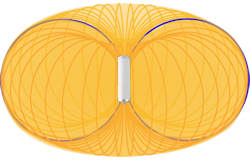
An omnidirectional (or “omni”) antenna radiates and receives power in all directions (360°) in a horizontal plane around it.
An omni antenna’s radiation pattern is in the shape of a donut or an inner tube (pictured). As the antenna’s gain increases, that pattern becomes becomes wider and flatter, like a disc.
Omnidirectional antennas often have less gain and more noise than directional antennas that radiate and receive power more efficiently in one direction and need to be tuned (pointed or aimed) in the direction of signal. Despite these drawbacks, an omni antenna is the better choice if you need to receive signal from multiple cell towers that are in different directions.
Types of omnidirectional antennas commonly used with cell phone signal boosters and cellular routers include desktop, dome, NMO, paddle, and whip antennas
Learn when to use a directional or omnidirectional antenna in our Knowledge Base.
Inadequate separation between a cell phone signal booster’s outdoor donor antenna and its indoor broadcast antenna will result in the radiation patterns of the antennas overlapping each other. This can create oscillation, a feedback loop similar to a microphone that’s too close to the speaker it’s connected to.
If a cell signal booster detects oscillation, federal regulations require that it reduce its gain to try to resolve the problem. If the oscillation is too strong, the booster will shut down entirely. (See 47 CFR §20.21(e)(8)(ii)(A).)
Isolating the two antennas will prevent oscillation and allow the cell signal booster to operate normally. The booster will have lights, a display, or a smartphone app that will tell you if you need more antenna isolation.
See also: Overpower
Click here to learn more about troubleshooting cell signal booster lights.
Learn more about cell signal booster oscillation in our Knowledge Base.
An overpowering cell phone signal booster is providing too much amplification of the incoming signal received from the donor antenna. This most often happens when the outside signal received by the donor antenna is already very strong.
Because an overpowering booster can cause interference and disruption of the carrier’s cellular network, the booster’s automatic gain control (AGC) will reduce the gain to try to resolve the problem. If the overpower persists, the booster will shut down entirely to protect the cellular network.
If a booster is continually overpowering, the problem can often be fixed by pointing the directional donor antenna further away from the cell tower (detuning it) in small increments until the overpower condition stops occurring. Switching to a lower-gain donor antenna or adding an attenuator to the donor antenna’s coaxial cable may also resolve the problem.
See also: Oscillation
Click here to learn more about troubleshooting cell signal booster lights.
P
A paddle antenna is a thin, blade-shaped antenna that resembles a paddle used to propel a boat.
When used with a cell phone signal booster system, a paddle antenna functions as the indoor broadcast antenna and is connected directly to the booster. Because of its compact size, the paddle antennas can be a good option for booster systems used in passenger vehicles, RVs, trailers, and small homes.
See also: Whip antenna
Click here to see the TS210503 paddle antenna available from Powerful Signal.
A panel antenna is a box-shaped directional antenna with mounting points on its back side and its front side aimed in the direction of transmitted signal.
In a cell phone signal booster system, a panel antenna is most commonly used as the indoor broadcast antenna to send and receive signal to and from cell phones and other cellular devices inside a building, RV, or trailer. It’s typically installed on the inside of an exterior wall or in the corner of a room or building and pointed toward the area where indoor cell signal coverage is needed. Panel antennas can be the best choice for covering long, narrow indoor spaces, like hallways, ranch-style homes, and motorhomes.
A water-resistant panel antenna can also be used as an outdoor donor antenna to send and receive signal to and from a cell tower. Like all directional antennas, it must be pointed at (tuned to) a specific cell tower. When used as a donor antenna, a panel antenna is less efficient than an LPDA because of its wider beamwidth.
Click here to see home and office broadcast antennas available from Powerful Signal.
A parabolic antenna is a directional antenna with a curved reflector that directs signal to a feed element positioned in front it.
As waves of cellular or other radio or microwave signals strike the reflector, they bounce off and converge at the feed element. This give a parabolic antenna a high level of energy concentration (gain), allowing for very efficient transmission and reception of signals.
In a cell phone signal booster system, a parabolic antenna is used as an outdoor donor antenna to send and receive signal to and from a cell tower. Like all directional antennas, it must be pointed at (tuned to) a specific cell tower; because of its very narrow beamwidth, though, it requires precise tuning and often a direct line of sight to the cell tower.
Click here to see the TS242601 parabolic antenna available from Powerful Signal.
See: DAS
The Personal Communications Service (PCS) occupies a spectrum of low-band cellular frequencies between 1850 and 1995 MHz.
PCS came into service to provide additional capacity beyond CLR for 2G cellular phones. It continues to be used by major cellular carriers for 4G and 5G service.
The PCS spectrum was originally auctioned off to carriers as band 2, blocks A–F. More spectrum was opened later with band 25, which adds additional block G; this band was licensed to Sprint and is now controlled by T-Mobile.
Cellular spectrum chart for 1900 MHz (SMH), which includes band 25 and band 2 (which is a subset of band 25):
PCS blocks A–F (and sometimes G) are amplified by five-band cell phone signal boosters.
See also: Service
See: Anchor band
A plenum space is a part of a building used for air circulation for heating and air conditioning systems. Space between the structural ceiling and the dropped ceiling or under a raised floor is typically considered plenum.
Plenum coaxial cable is laid in plenum spaces. Plenum cable has a special outer jacket made from fire-resistant materials and will not produce toxic fumes that could prevent people from evacuating the building in the event of a fire.
Click here to see half-inch plenum air coax cables available from Powerful Signal.
A port is a connector on a cell phone signal booster.
A power supply converts electrical current from a source to the correct voltage, current, and frequency used by an electrical or electronic device.
For example, the electrical outlets in most buildings in the United States and Canada supply 120 volts AC, but most personal electronic devices—including cell phone signal boosters—use 12 volts DC. An AC/DC power supply (or AC adapter) plugs into the wall outlet and converts 120V AC to 12V DC that can be used by the device.
The electric cigarette lighter socket, standard equipment in most automobiles since the 1950s, has recently been repurposed as an auxiliary power port to provide 12V DC directly to electronic devices, including cell signal boosters. A hardwire power supply connects directly to the vehicle’s battery and also provides 12V DC power.
Click here to see cell signal booster power supplies available from Powerful Signal.
A wireless public safety system is a communications system inside a commercial building used by firefighters and other emergency responders to coordinate evacuation, rescue, and fire suppression. The system operates on the frequencies used by local first-responder radios, and the equipment is designed to continue operating for a period of time after being exposed to flames.
FirstNet is a type of public safety network that uses specially designed cellular phones and frequencies.
Click here to see public safety systems available from Powerful Signal.
R
Note: All energy is referred to as radiation, even radio signals which are not dangerous to humans. See Electromagnetic spectrum.
An antenna radiation pattern is a diagram that shows how an antenna sends out or receives radio waves in different directions. It tells you the direction(s) where the antenna is better at sending or receiving signals (has higher gain) and the directions where it’s not as good.
We can compare an antenna to a flashlight: The light emitted by a flashlight is brightest in the center of the direction it’s pointed and dimmer the farther you get from that centerline; eventually you reach a point from the centerline where there is no light being emitted. The radiation pattern of an antenna is similar but for radio waves instead of visible light.
The parts of the radiation pattern where the antenna signal is strongest are called lobes. (These are represented by the blue line in the accompanying image.) The main lobe is the strongest, like the center of the flashlight beam; smaller lobes on the sides are not as strong as the main lobe. Areas where the antenna doesn’t work as well or at all are called nulls.
Engineers design antennas with specific radiation patterns to suit different communication needs.
See also: Beamwidth; Directional antenna; Omnidirectional antenna.
Radio waves are electromagnetic waves with frequencies between 3 Hz and 3000 GHz and wavelengths from 3,000 kilometers to 0.1 millimeters.
Radio signaling and communication are widely used for radio and television broadcasting, radio and cellular communication, WiFi networking, satellite transmission, radar, radio navigation, and other applications.
Microwaves fall within the radio spectrum. Cellular frequencies fall mostly within the microwave spectrum.
In 2014, the FCC adopted new rules that require each user of a consumer cell phone signal booster to register their booster with their wireless carrier. This requirement is intended to make it easier for carriers to correct network problems that would occur in the unlikely event that a booster were to fail or be incorrectly configured.
FCC-certified boosters—including all consumer boosters sold by Powerful Signal—are preapproved by major cellular carriers, and registering your cell signal booster with your carrier is quick and simple. Your registration will not be declined or refused, and your carrier will not require any licensing or documentation.
See also: Industrial cell phone signal booster
RG-6 coax is a 75-ohm coaxial cable with an outer diameter of 0.27″ (6.86 mm).
Many consumers are familiar with RG-6, since it’s the same type of coax used with cable TV systems.
RG-6 coax has more attenuation than RG-11 coax but is thinner and more flexible. Its size and flexibility make it common choice for runs of cable up to 30′ for use with 75-ohm cell phone signal boosters in small to midsized homes.
RG-6 is terminated with F-male connectors.
Click here to see RG‑6 coax cables available from Powerful Signal.
RG-11 coax is a 75-ohm coaxial cable with an outer diameter of 0.398″ (10.1 mm).
RG-11 coax has less attenuation than RG-6 coax but is thicker and somewhat less flexible. Its low-loss makes it a better choice than RG-6 for runs of cable up to 100′ for use with 75-ohm cell phone signal boosters in homes and businesses.
RG-11 is terminated with F-male connectors.
Click here to see RG‑11 coax cables available from Powerful Signal.
RG-58 coax is a 50-ohm coaxial cable with an outer diameter of 0.197″ (5.0 mm).
RG-58’s low cost, size, and flexibility make it a common solution in runs up to 30′ for use with 50-ohm cell phone signal boosters in passenger vehicles, RVs, and boats. It’s also frequently used as a short jumper cable to provide strain relief and adapt different types of connectors.
RG58 coax has significantly more attenuation than 195 coax, even though the two cables are nearly the same diameter. This makes 195 coax the preferred cable type in runs longer than 15 feet.
RG-58 coax is terminated with many types of connectors of both genders, including SMA, SMB, FME, and N.
Click here to see RG‑58 coax cables available from Powerful Signal.

RG-174 coax is a 50-ohm coaxial cable with an outer diameter of 0.110″ (2.79 mm).
RG-174’s size and flexibility make it a good solution in runs up to 15′ for use with 50-ohm cell phone signal boosters in passenger vehicles. It has largely been replaced by 100 coax, which has the same diameter but significantly less attenuation.
RG-174 coax is commonly terminated with FME-female or SMA-male connectors.
See: Cellular router
See: SMA connector
Reference Signal Received Power (RSRP) is a metric used to measure the strength of received signal in an LTE cellular network.
The RSRP number indicates how strong the downlink power received from the cell tower is. All other things being equal, the closer a phone is to the cell tower, the higher the received band’s RSRP value will be. A cell phone signal booster amplifies the RSRP of available signal, providing more reliable calls and faster cellular data.
RSRP is measured in decibel-milliwatts (dBm). (See the entry on dBm for more information about how this is calculated.)
A phone’s RSRP reading can be determined in the settings menu of an Android phone or using Field Test Mode on an iPhone. (Click here for instructions.)
Reference Signal Received Quality (RSRQ) is a metric used to measure the quality of received signal in an LTE cellular network.
The RSRQ number indicates how strong the signal is compared to the background noise and interference. More simply, RSRQ helps us understand how clear and reliable the communication is between a mobile device and the cell tower.
Higher RSRQ values indicate better signal quality, while lower values might mean there’s more noise or interference affecting the signal.
A phone’s RSRQ reading can be determined with an Android app or using Field Test Mode on an iPhone. (Click here for instructions.)
While a cell phone signal booster itself cannot improve RSRQ, a directional donor antenna used with a booster can help avoid interference from other cell towers and improve a cell phone’s RSRQ.
See: Whip antenna
S
See: Broadcast antenna
A service (also referred to as a bandplan) is a spectrum of radio frequencies composed of one or more bands grouped together for easy identification and licensing by the FCC.
For example, frequencies between 698 MHz and 806 MHz are part of the Lower SMH and Upper SMH service, which the FCC has licensed for use with cellular communications:
The serving cell is the base station that your phone is connected to and receiving data from at that moment.
If your phone is using carrier aggregation, the primary component carrier (PCC) is the “main cell” to which all your phone’s uplink data is sent, while your phone will download data from the PCC and one or more secondary component carriers (SCCs).
See also: Neighbor cell
Super high frequency (SHF) is the international designation for the radio frequency spectrum between 3 and 30 GHz. Wavelengths in this spectrum range from 1 to 10 centimeters.
These frequencies fall within the microwave spectrum, so radio waves with these frequencies are called microwaves.
Mid-band and some mmWave cellular frequencies exist within the SHF spectrum.
See also: Band; Channel; EHF; Electromagnetic spectrum; Hz; UHF
A signal meter (also called a spectrum analyzer) is an electronic device that scans for the presence of radio frequencies and displays their signal strength (RSRP) and related data.
The meter displays the results on a screen or a smartphone app. The data collected at various scan points can be downloaded to a computer for analysis.
Signal meters are used by professional installers of cell phone signal booster and DAS systems to test signal strength inside a building before and after a cellular amplifier has been installed.
A signal meter provides data for a wide range of frequencies, including cellular, WiFi, television, GPS, radio, and so forth. A network scanner is a specialized signal meter that looks only for cellular signals and provides data specific to them, including the carrier and the cell tower ID number.
Learn more about professional installation of a cellular amplification system.

A subscriber identity module (SIM) card is a small, removable card used in cell phones, cellular routers, mobile hotspots, and other cellular devices to identify the device to and authenticate it on the carrier’s cellular network.
SIM cards come in different sizes; the most common type is the nano SIM, which is about the size of a fingernail (12.3 × 8.8 mm).
Some cellular devices now use an eSIM (embedded SIM) that’s built directly into the device and can be provisioned remotely, eliminating the need for a physical SIM card.
A single-band cell phone signal booster amplifies one band of cellular signal, typically an anchor band in the SMH spectrum.
Single-band amplifiers are designed and marketed mostly for use in remote and rural areas that have access to just one long-distance low-band frequency like band 12 (AT&T, T-Mobile) or band 13 (Verizon).
Many single-band booster kits are cheap, low-quality units that do not perform as reliably or have as much indoor coverage area as quality five-band boosters.
See also: Carrier-specific cell phone signal booster; Dual-band cell phone signal booster
Signal to Interference-plus-Noise Ratio (SINR, pronounced “sigh-nar”) is a metric used to compare the power of desired cellular signal to the combined power of interference and noise.
SINR is a ratio (R) calculated as R=S/(I+N), where S is the desired signal coming from the cellular tower; I is interference caused by unwanted signals from sources other than the serving cell tower; and N is random noise from electronic components, atmospheric conditions, etc.
Higher SINR values indicate better signal quality and stronger overall connection performance.
A phone’s SINR reading can be determined with an Android app or using Field Test Mode on an iPhone. (Click here for instructions.)
While a cell phone signal booster itself cannot improve SINR, a directional donor antenna used with a booster can help avoid interference from other cell towers and improve a cell phone’s SINR.
Single Input, Single Output (MIMO, “sigh-so”) is a wireless system that sends and receives signal through one antenna.
Cell phone signal boosters typically use one SISO donor antenna, although some commercial systems have multiple donor inputs (MIMO) for different bands of frequency or to send and receive signal for specific carriers.
The SMA (“SubMiniature version A”) connector is used with 50-ohm coaxial cables and cell phone signal boosters.
The SMA-male connector has a center pin, is threaded on the inside, and has an outer diameter of 9 mm. The SMA-female connector has a receptacle for the pin, is threaded on the outside, and has an outer diameter of 6.2 mm.
SMA-female connectors are commonly used on 100, 195, and RG-58 coax cables.
Reverse-polarity SMA connectors (RP-SMA) have a male connector with a center pin and threads on the outside; the female connector has a receptacle for the pin and threads on the inside. RP-SMA connectors are used with some cellular-WiFi routers to prevent consumers from connecting a high-gain antenna to the router.
Note: SMA connectors and F connectors are similar in appearance, but F connectors are larger than SMA.
The SMB (“SubMiniature version B”) connector is used with 50-ohm coaxial cables and cell phone signal boosters.
The SMB-male (or jack) connector has a center pin and an outer diameter of 3.8 mm. The SMB-female (or plug) connector has a receptacle for the pin and an outer diameter of 6.5 mm. Instead being threaded like the SMA connector, the SMB’s male connector snaps into the female connector’s basket.
SMB-female connectors are occasionally used on 100 and RG-58 coax cables.
The SMB connector was used in weBoost Drive Reach mobile cell signal booster kits from 2019 until early 2022, after which the manufacturer switched to SMA connectors.
The Seven hundred MHz (SMH) service occupies a spectrum of low-band cellular frequencies between 698 and 806 MHz.
The SMH spectrum was first auctioned off by the FCC in 2008 to provide additional capacity for 3G and 4G cellular phones in remote and rural areas. Prior to that, it was used by UHF television channels 52–69.
The Lower SMH spectrum is comprised of band 12 (blocks A, B, and C) and an overlapping band 17 (blocks B and C) that uses narrower electronic filters and different signaling protocols. Band 29 added additional downlink spectrum for carrier aggregation.
The Upper SMH spectrum is comprised of band 13, which is used for consumer cellular service, and band 14, which is dedicated exclusively to the FirstNet cellular public safety network.
Many 4G and 5G cellular phones use a band in the SMH spectrum as their anchor band.
SMH bands 12, 17, and 13 are amplified by five-band cell phone signal boosters. SMH bands 12 and 14 are amplified by FirstNet cell phone signal boosters.
See also: Service
A splitter divides the signal from a coaxial cable into two or more runs, sending an equal amount of signal to multiple antennas.
Splitting signal does not increase the coverage area of a cell phone signal booster; it divides it equally so it can be sent to two or more specific areas inside a building. For example, a cell signal booster that can provide 2,000 square feet of indoor coverage with one broadcast antenna would be able to provide 1,000 square feet for each antenna with a two-way splitter and 500 square feet for each antenna with a four-way splitter.
A splitter can also be used to join signal from two or more donor antennas into a single run to the donor port (connector) of a cell signal booster.
Unused ports on a splitter must be capped with a terminator.
If you need to divide signal unequally, you would use a coupler.
Splitters are used often in commercial and residential cell signal booster installations. Powerful Signal offers custom booster kits with a splitter and two or more indoor antennas.
See: 5G standalone
Sub-6 frequencies collectively refers to low-band and mid-band frequencies below 6 GHz that provide 4G and 5G cellular service.
Sub-6 frequencies travel farther and penetrate building walls better than high-band mmWave frequencies, but offer slower data speeds.
A surge protector is device intended to protect electrical components (like cell phone signal boosters) from voltage spikes in alternating current (AC) circuits.
Most cell signal booster manufacturers’ warranties require that the booster use a surge protector with a rating of at least 1,000 joules.
Not to be confused with: Lightning surge protector
T
See: Coupler
A terminator is a component that caps (terminates) an unused connector on a cell phone signal booster or splitter.
Unused cell signal booster ports that are not terminated will leak signal and potentially cause oscillation within the booster.

Terminator 2: Judgment Day is a 1991 science-fiction action film directed by James Cameron.
Not to be confused with: Terminator
The TNC (“Threaded Neill–Concelman”) connector is used with 50-ohm coaxial cables.
The TNC-male connector has a center pin, is threaded on the inside, and has an outer diameter of 15 mm. The TNC-female connector has a receptacle for the pin, is threaded on the outside, and has an outer diameter of 9.6 mm.
TNC connectors have been employed in a wide range of radio and wired applications. They are no longer used with cellular phones or cell phone signal boosters.
U
Ultra high frequency (UHF) is the international designation for the radio frequency spectrum between 300 and 3000 MHz (0.3–3 GHz). Wavelengths in this spectrum range from 1 meter to 10 centimeters.
Low-band and some mid-band cellular frequencies exist within the UHF spectrum.
See also: Band; Channel; EHF; Electromagnetic spectrum; Hz; SHF
Uplink refers to the signal transmitted from a smartphone, cell phone signal booster, cellular router, or other cellular device and received by a cell tower.
See also: Downlink; Uplink power
Uplink power is the strength of the signal transmitted by a smartphone, cell phone signal booster, cellular router, or other cellular device and received by a cell tower.
Uplink power is measured in decibel-milliwatts (dBm), with 0 dBm being equal to 1 milliwatt (mW). The transmitted uplink power (EIRP) of a 4G cell phone is limited to 23 dBm (200 mW), while a cell signal booster can have up to 30 dBm (1,000 mW)—five times as much. This additional uplink power gives cell signal boosters the ability to connect to towers in remote and rural locations, where a phone may not be able to make a connection.
See also: Downlink power
Learn more about uplink and downlink power in our Knowledge Base.
V
Due to impedance, some of the feeding signal (or forward power) projected by an antenna is reflected (reverse signal). The feeding signal and the reflected signal combine into a single wave called a standing wave.
Voltage Standing Wave Ratio (VSWR, pronounced “viz-whar”) is the ratio of the maximum voltage (Vmax) and the minimum voltage (Vmin) of the standing wave. The greater the VSWR figure, the more power is reflected by the antenna at that frequency.
In this animation, the green wave is the forward power, the red wave is the reflected power due to impedance mismatch, and the blue wave is the resulting standing wave. At this frequency, this antenna has a Vmax of 1.5 and a Vmin of 0.5, which results in a VSWR of 3 and reflection coefficient of 25%.
 Animation courtesy of Fred Cirera, 0x9900.com. Used with permission.
Animation courtesy of Fred Cirera, 0x9900.com. Used with permission.
When comparing two antennas with the same amount of gain, the antenna with lower VSWR numbers in key cellular frequencies is going to deliver more signal to a cellular booster or cellular router.
For example, an antenna with a VSWR 1.75 reflects 7.4% of the signal it receives at that frequency, while an antenna with a VSWR of 2.00 reflects 11.1% of the signal it receives at that frequency.
W
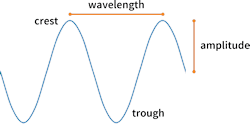
Wavelength is the distance between two identical, adjacent points in a wave, such as between two adjacent crests or two adjacent troughs.
The number of complete cycles (peak–trough–peak) in one second determines the wave’s frequency. One cycle per second is 1 hertz (Hz); one million cycles per second is 1 megahertz (MHz).
Wavelengths are measured in units like meters (m), centimeters (cm), and millimeters (mm). Longer wavelengths have lower frequencies and lower energy; smaller wavelengths have higher frequencies and greater energy.
See also: Electromagnetic spectrum
The Wireless Communications Service (WCS) occupies a spectrum of mid-band cellular frequencies between 2305 and 2315 MHz (uplink) and between 2350 and 2360 MHz (downlink). It is licensed by the FCC as band 30 for use with cellular networks.
WCS is currently amplified by a few industrial cell phone signal boosters.
See also: Service
A whip antenna is an omnidirectional antenna consisting of a straight rod or flexible wire (a monopole design). The bottom end of the antenna is a connector or has a coaxial cable.
For use with a cell phone signal booster, a whip antenna can be designed for use as a vehicle’s outdoor donor antenna or as an indoor broadcast antenna.
A tall donor antenna is typically attached to a spring mount to allow the antenna to bend back if it is struck going under a low overpass. A short donor antenna may have a magnet mount at its base.
Whip antennas are commonly covered with fiberglass or plastic for protection from inclement weather and unintentional impact damage. A short whip antenna with a rubber or plastic outer covering is often referred to as a “rubber ducky” antenna.
See also: NMO antenna; Paddle antenna
Click here to see vehicle antennas available from Powerful Signal.
A wideband antenna (also called a broadband antenna) is efficient over a wide spectrum of frequencies. In exchange for its wide frequency range, it usually has lower gain and more noise than a narrowband antenna.
An LPDA antenna is an example of a wideband directional antenna.

WiFi (trademarked with the spelling “Wi-Fi™”) is a family of network protocols that are used to create local area wireless networks. WiFi is commonly used by laptop computers, smartphones, smart TVs, and IoT devices access the internet.
WiFi networks are short-range (usually less than 200 feet), set up and managed by the end user, and are often password-protected to only allow authorized devices to connect to them. This differs from cellular networks, which are long-range (up to 20 miles), controlled by cellular carriers, and require a paid cellular plan and activated SIM card inside the device to use them.
WiFi operates on two bands of frequency. (See: WiFi frequencies.) Lower-frequency 2.4 GHz bands travel farther and penetrate walls more easily, but they offer slower data speeds. Higher-frequency 5.2 to 5.8 GHz bands travel shorter distances and do not penetrate walls as easily, but they offer faster data speeds.
A cellular router receives cellular signal and converts it to WiFi for use by computers, TVs, and other devices that do not have cellular capabilities.
WiFi calling (or VoWiFi) allows a smartphone with an activated SIM card to access the carrier’s cellular network and make voice calls through a WiFi connection. This allows the phone’s user to make calls even if they don’t have cellular reception.
WiFi calling is an optional feature in most modern smartphones that can be enabled in the phone’s settings menu.
WiFi calling is a possible alternative to using a cell phone signal booster. The upside to using WiFi calling over a cell signal booster is there is no additional equipment to purchase, as long as you already have a WiFi router and access to high-speed internet. The downsides to WiFi calling include:
- You will have to give your WiFi password to any individual in your home or office who wants to use WiFi calling; they will need to connect to your WiFi network and enable WiFi calling on their phone. A cell phone signal booster, on the other hand, is seamless; their phone will automatically use it once they enter the building.
- A WiFi phone call in progress will not hand off to a cell tower if you get out of range of your WiFi network; your phone will just drop the call and you’ll have to redial. A call enabled by a cell signal booster, however, will hand off to a tower if you get out of range of the booster’s donor antenna (assuming there is enough ambient cell signal to take over the call).
- A power outage at your home or office will probably take down your high-speed internet and/or WiFi router. Cell towers typically remain operating during a power outage; with a cell signal booster’s power supply connected to a backup battery system, you should still be able to make cellular calls (including emergency calls) if the power goes out.
Click here to see cell phone signal boosters for homes available from Powerful Signal.
Click here to see cell phone signal boosters for offices from Powerful Signal.
WiFi operates on three bands of frequency:
- The 2.4 GHz band (2401–2483 MHz) was the first band available for WiFi. These lowest WiFi frequencies travel farther and penetrate walls more easily, but they offer the slowest WiFi data speeds.
- As WiFi became more widespread, there was a need for more bandwidth and an increasing demand for faster data. Signals on the higher-frequency 5 GHz band (5150–5895 MHz) offer faster data speeds than 2.4 GHz WiFi, but they travel shorter distances and do not penetrate walls as easily.
- The latest spectrum available for WiFi is the 6 GHz band (5925–7125 MHz). It offers even faster data and more than doubles the available spectrum that can be used by WiFi routers and devices. Broadcast distance and penetration continue to be a problem, mesh WiFi routers are helping to resolve those issues.
A WiFi hotspot(or mobile hotspot) is a device that converts cellular data to WiFi data, allowing laptops, tablets, and other WiFi-enabled devices to browse the internet through a cellular connection. The hotspot has a SIM card and a data plan with a cellular carrier.
Many modern smartphones can act as hotspot devices. This option is usually enabled in the phone’s Settings menu. (Check with your carrier to see if this option is available with your phone and plan.)
A cellular router is an example of an advanced type of hotspot device.
See: Cellular router
Y
A Yagi–Uda antenna (named for the two Japanese engineers who invented the design) is a type of narrowband directional antenna.
The Yagi design is an assembly of dipole elements, with each pair of elements are nearly the same length along the entire boom. One pair of elements (the feed element or driven element) transmits and receives signal to and from an attached coaxial cable; the other elements direct or reflect the signal to the feed element. Because the dipole elements are similar in width and only one pair of elements is active, the Yagi antenna design works on a very narrow range of frequencies—typically just a single band.
A Yagi antenna is sometimes used as a cell phone signal booster’s donor antenna, sending and receiving signal to and from a cell tower. A Yagi antenna may be a good choice if there is only one band of frequency available in the area. Like all directional antennas, a Yagi antenna must be pointed at (tuned to) a specific cell tower.
Wideband LPDA antennas are sometimes incorrectly referred to as “Yagi antennas,” but the design and function of LPDAs and Yagis are different and distinct from each other.
Learn more about the differences between LPDA and Yagi antennas in our Knowledge Base.
Click here to see home and office donor antennas available from Powerful Signal.

